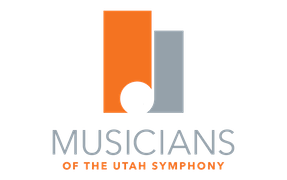Boston & Niagara Falls
We had an early start from Hopewell Junction and a smooth ride into Boston. Well, sort of smooth. Big cities like Boston, Philadelphia, New York, etc. have some common traits when it comes to the roads, the drivers and the congestion. We must be lucky in Salt Lake City, where the roads are most often straight, wide and without excessive amounts of potholes. The narrow streets, circles or roundabouts and impatient drivers of a city like Boston make driving a real thrill ride. At any minute we felt on the verge of being side-swiped, rear-ended, tail-gated, cut off, honked at or flipped-off. That we escaped without a scratch is a minor miracle.
Meeting us for lunch at Symphony Sushi in Boston was Richard Svoboda and his wife, Liz Foulser. It was a fun hour (or however long we had left on the parking meter). It was interesting to hear about life as a musician in Boston and brag about stealing Erin Svoboda away from New England. Liz and Richard were animated and entertaining. Their choice in restaurants was good too.
Lisa had found another Airbnb for our two days in Boston. This proved to be in a wonderful spot, not too far from Symphony Hall and the New England Conservatory. We by chance ran into my Curtis classmate, John Ferrillo, at Moby Dick’s of Boston. It probably wasn’t such a surprise as John and I had eaten there together a couple of years ago and Richard Svoboda called it “John’s Second Home”. Because John’s real home is almost two hours away, he spends a lot of time in the city. He was in his running clothes. We had a great time catching up and John seemed especially relaxed considering he was scheduled to play Bach’s “Wedding Cantata” in a few hours. The recital at NEC was very good. We heard Beethoven’s “Storm” Quintet and Cantata #202 by Bach. Playing second violin in the Beethoven was Kristopher Tong, former student of Leonard Braus. The quintet played with excellent ensemble and character. Hearing John play the “Wedding Cantata” was a real treat. His playing had personality and beauty. Lisa Saffer did a beautiful job singing the soprano arias.
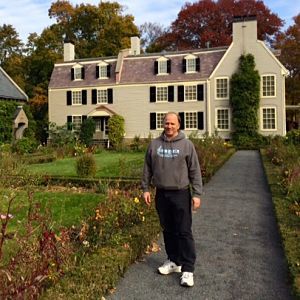
John Adams house
The next morning we took off for Quincy and the home of John Adams, his son John Quincy and two more generations of Adams. We got a tour of the first Adams home and then the “Old House” where the Adams name appeared on the mailbox for more than 100 years. Like the other Presidential homes, a keyboard was amongst the pieces of colonial furniture. John Adams’ favorite instrument was the organ and the church where the Adams worshipped and heard an organ on a weekly basis was close by. The tour guides helped illuminate this dynamic father/son combination, their time in history and their love of country. John Adams, unlike other Founding Fathers, refused to own slaves and had a vision of the future. He was famous for saying, “I must study politics and war that my sons may have liberty to study mathematics and philosophy. My sons ought to study mathematics and philosophy, geography, natural history, naval architecture, navigation, commerce and agriculture, in order to give their children a right to study painting, poetry, music, architecture, statuary, tapestry and porcelain.”
We had some great Indian food on Adams Street in Quincy. It’s a town that celebrates the Adams name. Joining us for dinner in Boston was Lynn and Theresa Larsen, both former members of the Utah Symphony, and John Ferrillo. We ate at John’s “Second Home”. The food tasted familiar. Lynn is of course the orchestra and personnel manager for the Boston Symphony and Theresa plays cello (mostly with the BSO). Theresa and I were also classmates in high school and at the Academy of the West, and our kids are of a similar age. There was plenty to talk about, but much of the discussion centered around conductors. Because John has played in San Francisco and the Met, he’s seen some pretty good conductors. Thierry Fischer had just conducted Nielsen in Boston and the reviews were favorable.
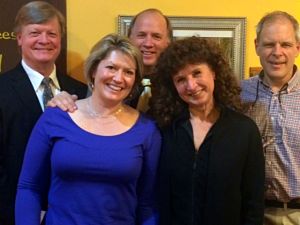
Lynn Larsen, Lisa, Bob, Theresa Larsen & John Ferrillo
John gave us a great tour of Symphony Hall. There are walls, statues and displays devoted to the history of the orchestra. Gift shops, restaurants and bars are plentiful. We ran into associate principal oboist, Keisuke Wakao, before the concert. Lisa and Keisuke had been in New World together, so that was a fun reunion. The area under and around the hall is vast, and John explained that the Boston Symphony has same excellent investors. Much of the surrounding real estate belongs to the Boston Symphony.
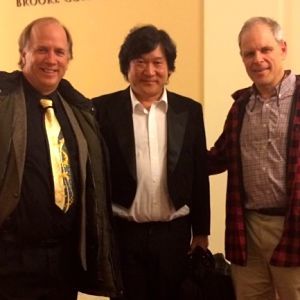
Bob, Keisuke Wakao & John Ferrillo
The 8:00 concert featured the Sibelius Violin Concerto and the Schubert Symphony in C, “The Great”. The soloist was Frank Peter Zimmermann, who raced through the concerto and a Bach encore with mechanical precision. It was great to hear another fabulous orchestra. The clarinets, the strings, Richard Svoboda and Keisuke were at the top of their game. Our seats, which faced at right angles to the stage, were also quite uncomfortable. We made a switch that brought us from that first tier in the back to something closer. Acoustically both spots were good. The degree of twisting to see the orchestra had been mildly reduced. Stars make up most of the Boston Symphony, but the wind playing in the Schubert was especially outstanding. Besides John Ferrillo, we got to enjoy Elizabeth Rowe playing first flute. They make a winning combination and afterwards we would see them both along with Steve Ansell, another Curtis classmate.

Lisa, Elizabeth Rowe & John Ferrillo
Leaving early again, we made a stop in Stockbridge to see the Norman Rockwell Museum. His long career as an illustrator was well documented. His actual studio was moved from an area by Main Street to the country where the museum is situated. One of the guides told us Rockwell liked to listen to Italian opera when he painted. All of his works tell a story. We took advantage of the gift shop and had lunch at the historic Red Lion Inn, a hotel that is more than 200 years old. It is one of the buildings featured in Rockwell’s painting, “Christmas on Main Street”. He liked to use locals for models, so as we strolled down Main Street we imagined seeing some familiar faces, or perhaps the descendants of people in his work.

Norman Rockwell studio
We continued the drive northwest on Interstate 90 and found our hotel close by Niagara Falls. We went exploring and saw the falls for the first time. They were very dramatic and very loud. More than a hundred years ago Gustav Mahler said about the falls, “Finally, a fortissimo!” Catching the falls in November meant fewer crowds and access to the observatory which hung over the river connecting Lake Erie and Lake Ontario, was free of charge. We could still hear the falls from our hotel.
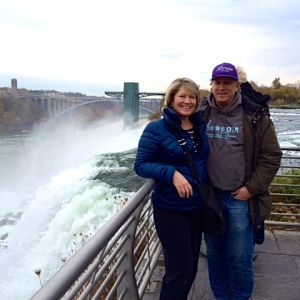
Niagara Falls
We had arranged for our passports to be sent to us while in Hopewell Junction, NY. This made it possible to see Niagara Falls from Canada. The view from Canada is the best. Towering hotels and casinos make the most of the view. A lot of foreign languages and snapping pictures were a part of an excited audience. Whether it was raining or misting heavily, most people had the sense to wear water-repellant jackets. Umbrellas were the norm. It was a nice introduction to our “Sister from the North”.
It was still a long trip back to Interlochen, but fifteen days after we left the cottage by the lake, we had finally returned.
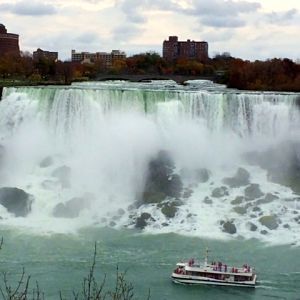
Maid of the Mist
The leaves had fallen off the trees by the lake and a full moon began to rise over the water. It felt like winter was on the way.
– Robert Stephenson and Lisa Byrnes
